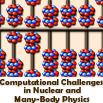Speaker
Raymond Bishop
Description
The coupled cluster method [1] (CCM) is one of the most
pervasive, most powerful, and most successful of all ab
initio formulations of quantum many-body theory. It has
probably been applied to more systems in quantum field
theory, quantum chemistry, nuclear, subnuclear, condensed
matter and other areas of physics than any other competing
method. The CCM has yielded numerical results which are
among the most accurate available for an incredibly wide
range of both finite and extended physical systems defined
on a spatial continuum. These range from atoms and molecules
of interest in quantum chemistry, where the method has long
been the recognized "gold standard", to atomic nuclei; from
the electron gas to dense nuclear and baryonic matter; and
from models in quantum optics, quantum electronics, and
solid-state optoelectronics to field theories of strongly
interacting nucleons and pions.
This widespread success for both finite and extended
physical systems defined on a spatial continuum [2] has led
to recent applications to corresponding quantum-mechanical
systems defined on an extended regular spatial lattice.
Such lattice systems are nowadays the subject of intense
theoretical study. They include many examples of systems
characterized by novel ground states which display quantum
order in some region of the Hamiltonian parameter space,
delimited by critical values which mark the corresponding
quantum phase transitions. The quantum critical phenomena
often differ profoundly from their classical counterparts,
and the subtle
correlations present usually cannot easily be treated by
standard many-body techniques (e.g., perturbation theory or
mean-field approximations). A key challenge for modern
quantum many-body theory has been to develop microscopic
techniques capable of handling both these novel and more
traditional systems. Our recent work shows that the CCM is
capable of bridging this divide. We have shown how the
systematic inclusion of multispin correlations for a wide
variety of quantum spin-lattice problems can be efficiently
implemented with the CCM [3]. The method is not restricted
to bipartite lattices or to non-frustrated systems, and can
thus deal with problems where most alternative techniques,
e.g., exact diagonalization of small lattices or quantum
Monte Carlo (QMC) simulations, are faced with specific
difficulties.
In this talk I describe our recent work that has applied the
CCM to strongly interacting and highly frustrated
spin-lattice models of interest in quantum magnetism,
especially in two spatial dimensions. I show how the CCM
may readily be
implemented to high orders in systematically improvable
hierarchies of approximations, e.g., in a localized
lattice-animal-based subsystem (LSUB$m$) scheme, by the use
of computer-algebraic techniques. Values for ground-state (and
excited-state) properties are obtained which are fully
competitive with those from other state-of-the-art methods,
including the much more computationally intensive QMC
techniques in the relatively rare (unfrustrated) cases where
the latter can be readily applied. I describe the method
itself, and illustrate its ability to give accurate
descriptions of the ground-state phase diagrams of a wide
variety of frustrated magnetic systems via a number of
topical examples of its high-order implementations, from
among a very large corpus of results for spin lattices. The
raw LSUB$m$ results are themselves generally excellent. I
show explicitly both how
they converge rapidly and can also be accurately
extrapolated in the truncation index, $m \to \infty$, to the
exact limit.
[1] R.F. Bishop, in "Microscopic Quantum Many-Body Theories
and Their Applications," (eds. J. Navarro and A. Polls),
Lecture Notes in Physics Vol. 510, Springer-Verlag, Berlin
(1998), 1.
[2] R.F. Bishop, Theor. Chim. Acta 80 (1991), 95; R.J.
Bartlett, J. Phys. Chem. 93 (1989), 1697.
[3] D.J.J. Farnell and R.F. Bishop, in "Quantum Magnetism,"
(eds. U. Schollwöck, J. Richter, D.J.J. Farnell and R.F.
Bishop), Lecture Notes in Physics Vol. 645, Springer-Verlag,
Berlin (2004), 307.

